
Ctenophorus is a genus of lizards, commonly known as comb-bearing dragons, found in Australia. They are in the dragon lizard family, known as Agamidae.
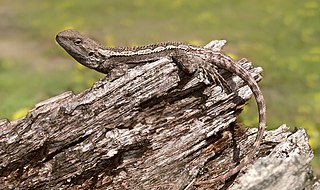
The jacky dragon is a type of lizard native to south-eastern Australia. Other common names include blood-sucker, stonewalker, and tree dragon. It was one of the first Australian reptiles to be named by Europeans, originally described by English zoologist George Shaw in Surgeon-General John White's Journal of a Voyage to New South Wales, published in London in 1790. The lizard is well-known for its bright yellow mouth and well-developed vertebral crest, as well as the temperature-dependent sex determination of its offspring.

Ctenophorus reticulatus, the western netted dragon or western netted ground-dragon, is a species of lizard in the family Agamidae. It is found in South Australia, Western Australia and southern Northern Territory.

Ctenophorus maculosus, commonly known as the Lake Eyre dragon or salt-lake ground-dragon, is a species of agamid lizard endemic to South Australia. C. maculosus mainly inhabits the edges of salt lakes in South Australia, from which its common names are derived. It survives in this harsh habitat through adaptive mechanisms to tolerate high temperatures and lack of free water. The female C. maculosus possesses unique male rejection techniques which are currently the focus of further research.

The central netted dragon or central netted ground dragon is a species of agamid lizard occurring in a wide range of arid to semiarid regions of Australia. It is widespread across the continent, commonly found in open, sandy, desert habitats. It is a popular pet and can often be found in zoos.

Ctenophorus pictus, commonly known as the painted ground-dragon or painted dragon, is a species of lizard from the family Agamidae. It is endemic to the drier areas of southern and central Australia.
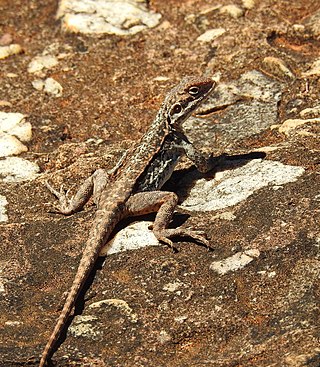
The Barrier Range dragon is an agamid lizard which has been newly described (2013) as a separate species from the tawny dragon. This species is endemic to Australia, restricted to just three sites in western New South Wales (NSW).
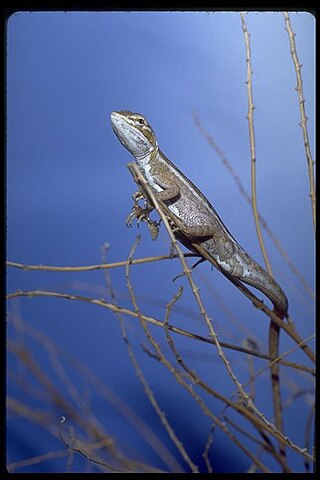
Diporiphora winneckei, also known commonly as the canegrass dragon, canegrass two-line dragon, blue-lined dragon, and Winnecke's two-pored dragon, is a species of small, terrestrial, diurnal lizard in the family Agamidae. The species is endemic to Australia. It is found throughout arid zones of Australia and is also a common house pet.

Ctenophorus fionni, also known commonly as the Arcoona rock dragon, the peninsula crevice-dragon and the peninsula dragon, is a species of lizard in the family Agamidae. The species is endemic to the Australian state of South Australia.
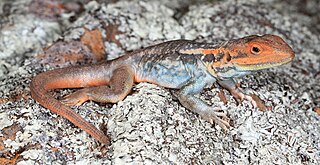
Ctenophorus decresii, also known commonly as the tawny dragon or the tawny crevice-dragon, is a species of lizard in the family Agamidae. The species is endemic to Australia. The average snout-to-vent length (SVL) of the species is 80.76 mm (3.180 in) with larger individuals being around 89 mm (3.5 in) and smaller individuals around 72 mm (2.8 in). The optimal time for mating in this species is two to three weeks after the females emerge from hibernation. Eggs are typically laid from September to October with most of them being laid earlier in the period. C. decresii is known for its variations in throat colours which change based on environmental conditions. Its primary food sources consist of both vegetation and invertebrates, and it prefers to live in rocky habitats.

Tympanocryptis tetraporophora, also known as Eyrean earless dragon or long-tailed earless dragon, is one of a documented species of a relatively small dragon belonging to the genus Tympanocryptis. Tympanocryptis is differentiated from other genera within the family Agamidae by a tympanum covered with scales and a missing phalange in the fifth toe of the rear foot. T. tetraporophora is a ground dwelling dragon inhabiting semi arid regions of central New South Wales, arid regions of South Australia, Northern Territory, Queensland and tropical grasslands of Northern Queensland.
The gibber earless dragon also known as the smooth-snouted earless dragon, is a species of agamid lizard endemic to Australia. It is one of a documented species of the genus Tympanocryptis, a group of small terrestrial lizards that feed off invertebrates and are characterised by the absence of an external ear structure.

The Mallee dragon, also commonly known as the Mallee dragon and the Mallee sand-dragon, is a species of lizard in the family Agamidae. The species is native to the arid parts of southern Australia.
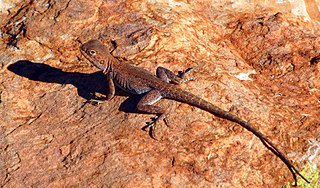
Ctenophorus caudicinctus, commonly known as the ring-tailed dragon or ring-tailed bicycle-dragon is a native species of agamid lizard occurring in rocky ranges and outcrops of Australia. Ctenophorus caudicinctus is most commonly found in the Pilbara region and offshore islands of Western Australia. The ctenophorus has 28 known species in the northern, southern, and western parts of Australia. It is recognized to be the most speciose group of Australian agamids.
Ctenophorus mckenziei, more commonly known as the dwarf-bicycle dragon, is a species of endemic Australian lizard within the family Agamidae and genus Ctenophorus. Originally identified as the agamid Amphibolurus mckenziei, the lizard had been identified within the regions of Western Australia and South Australia in which it occupied the shrubbery and woodland areas as its habitat. It was subsequently transferred to the genus Ctenophorus along with other Agamid species in which it shared similar morphology and characteristics. The name mckenziei is in reference to Norman Leslie Mckenzie, who was a zoologist and discovered the existence of the lizard. Listed on the IUCN red list page, threats to its population numbers are evaluated as least concern; however, their numbers are threatened by habitat loss, climate change, and feral predators.
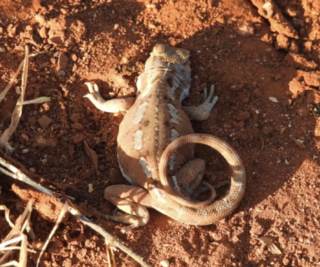
Ctenophorus parviceps, commonly known as the Gnaraloo heath dragon or northwestern heath dragon is a species of agamid lizard occurring in pale coastal sands and shell grit with open heaths and beach spinifex, between the North West Cape and Carnarvon, Western Australia and on Bernier Island. The Gnaraloo heath dragon is a lizard that can be found along the coast of Western Australia between Exmouth Gulf and Shark Bay, and is also known as the northwestern heath dragon. It is native to Australia and usually inhabits sandy coastal dunes. The species' longevity is 3–50 years and its population density is extremely low. The Gnaraloo heath dragon is a member of the Agamidae family, which contains 15 genera. The lizard is under the Ctenophorus genus which has up to 33 species. This genus shows the most morphological and ecological diversity out of the three large agamid genera. 83% of the lizards in this genus lack a crest, while 17% possess crests. They are smaller than most agamids but do have relatively large heads. The Gnaraloo heath dragon can be differentiated from related species by a series of spines on the tail's base, a pale-grey brown broad vertebral band along its back, and hour-glass bars extending upwards to meet the pale vertebral band. It is usually 45mm in terms of length, measuring from snout to vent.

Ctenophorus tjantjalka, also known as the ochre dragon, is a species of agamid lizard occurring on low, weathered, crumbling outcrops and stony hills in arid South Australia, from the Painted Hills north-west to the base of the Everard Ranges.

Ctenophorus spinodomus commonly known as Eastern Mallee Dragon, is a species of agamid lizard endemic to the arid and semi-arid regions of southeastern Australia. Belonging to the genus Ctenophorus, which comprises a diverse group of 35 species this small lizard is characterised by striking colours and unique behaviours. Commonly known as dragon lizards, spinodomus is derived from the Greek words "spinos" (thorn) and "domos" (house), referring to its preference for burrowing habitats among spiny vegetation. They are curious creatures and can be found darting between the safety of Triodia grass clumps or basking on the red sand.

The Mallee heath dragon, is a species of semi-Arboreal Agamidae endemic to Australia. it has also been referenced as Norris’s dragon, Mallee heath lashtail and Mallee heath lashtail dragon.

















